Although it is not the 5D Mark III that everyone has been waiting for, the new Canon EOS 1DX will certainly make its share of waves. With this morning’s announcement of the new 1DX, Canon has unified the 1D and 1Ds lines of cameras, replacing the 1Ds Mark III and the 1D Mark IV. In doing so, Canon had to build a camera that matched the speed and responsiveness of the Mark IV, and combine it with the image quality and flexibility of the Mark III. The result is a powerhouse that I predict will instantly be a favorite for journalists, cinematographers, and many other professionals as well.
At the heart of the 1DX is a new 18-megapixel, full-frame CMOS sensor. It seems that Canon has listened to the pros (and the marketplace) and instead of making a higher-resolution sensor, they concentrated on improving image quality, particularly at high-ISO. The lower resolution sensor allows Canon to use larger receptors (which have also been engineered for superior signal to noise ratio), allowing the sensor to operate at a native ISO range of 100-51200, plus an expanded range (H1 and H2) of 102400 and 204800!
The camera is powered by three processors: dual Digic-5+ processors for image and video processing, plus a Digic-4 dedicated solely to metering and auto-focus. Canon claims that their new Digic-5+ processors have 17 times the processing power of the previous generation. This power, coupled with a newly engineered carbon-fiber shutter system, allows the 1DX to shoot full resolution JPG files at 14 frames per second (in super high speed mode), faster than any other camera on the market. It shoots RAW files at a mere 12 frames per second. The AF system uses 61 cross-type p0ints, and is now capable of what Canon is calling “iTR AF” : intelligent subject tracking. iTR AF can detect faces and insure that they remain in focus, but is also detects other blocks of color, making AF of moving objects much more reliable. At least in theory. Time will tell how the system performs in the field, but Canon’s AF systems have rarely disappointed in the past.
It’s not surprising that Canon has also catered to the rapidly growing demographic of SLR Film-Makers. Probably of greatest interest here are the new recording formats; the previous h264 codec was hard to work with in post-production, and image quality was not always up to movie industry standards. The 1DX offers two new HD recording formats, one aimed at producing files that are easy to edit, and another with an emphasis on high image-quality compression. Furthermore, the 4GB file size limit has been overcome, allowing continuous recording for up to 29 minutes 59 seconds. Rather than using a different file system (like NTFS), Canon’s software seamlessly splits a video file into 4GB segments on the fly.
PRICE: $6800, estimated street price. Canon says that they’ll start shipping in March 2012, nearly 5 months from now. This is common practice for Nikon, but I’ve never seen Canon announce a camera so long before release.
And this is just the beginning. Over the next few days, I’ll be updating and discussing the new features and innovations found in the Canon EOS 1DX. Stay tuned!










